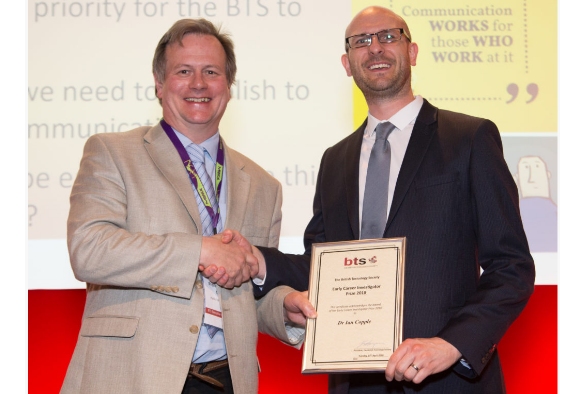Dr Ian Copple Awarded BTS Prize

At the British Toxicology Society Congress 2018, Dr Ian Copple of the Centre for Drug Safety Science was awarded the Society’s Early Career Investigator Prize for his research into the role of the NRF2 cell defence system in protection against drug-induced disease. The award is made in recognition of leading contributions to the field of toxicology by Early Career Investigators (within 10 years of PhD).
Ian’s research is centred on how cells sense chemicals (including therapeutic drugs) that could be stressful to them, how they mount an adaptive response to these stresses, and how these processes influence susceptibility to drug toxicity. The adaptive response could be to either detoxify the chemical, remove it from the cell, or limit its ability to cause damage to the cell. The NRF2 system is one of the main ways the cell does that; NRF2 is a transcription factor that controls the expression of a host of genes that can protect the cell via various mechanisms.
Ian explains, “We’ve been interested in how the NRF2 system senses stress, linked to drug toxicity, and how its response could potentially be used either to detect drug toxicity better than some of the markers that are currently used, or could be manipulated to reduce drug toxicity, or to try to recover from drug toxicity in a more effective way.”
Ian and his team were one of the first groups to show that chemical activators of the protective NRF2 response can physically modify the KEAP1 protein that interacts with NRF2 and regulates its activity. They found that KEAP1 is very sensitive to being modified by drugs that would otherwise go on to modify other important proteins in the cell, causing them to be damaged. Ian has also been involved in a number of studies that have defined the large sets of genes and proteins that NRF2 controls in different organs. Ian said, “These investigations furthered our understanding of how the NRF2 system both responds to and protects cells against stress, and have informed the design and development of drugs that can modulate NRF2 activity”.
Indeed, the group have recently been focusing on how the NRF2 system could be targeted therapeutically. Ian said, “There may be certain diseases, even outside of drug toxicity, that could be treated through the therapeutic manipulation of NRF2 with compounds that can trigger its activation in a safe way.” Importantly, a number of pharmaceutical companies are developing such drugs, and several have entered clinical trials in different disease areas.
Ian said, “For example, we’ve recently received funding from North West Cancer Research to test the potential of NRF2 stimulation as a means of improving the rate at which the liver regrows following surgery to resect tumours, an issue that can determine the suitability of liver cancer patients for surgery.”
If such an approach could be brought into the clinic, then patients who might currently be deemed unsuitable for surgery could be offered a potentially curative treatment, significantly improving their disease prognosis.
Centre for Drug Safety Science
Ian feels that working with the Centre for Drug Safety Science has benefited his career in two main ways.
Firstly, he has been able to form connections with relevant people in industry who are developing new drugs and know about the issues faced during toxicology testing; this has helped to guide Ian’s research and maximise its potential impact to industry.
Secondly, the Centre’s clinical contacts have been invaluable. For example, the Centre has excellent connections with surgeons at Aintree Hospital, home to the North Western Hepatobiliary Centre, a world-renowned institution serving a population in excess of three million people. Ian said, “Having those connections helps to ensure that the work that we’re doing is clinically relevant or could eventually influence clinical practice.”
Where is the research headed next?
Ian shared his view of the future of his research with us. He said, “That’s nicely exemplified by the TransQST project we’re involved in at the Centre for Drug Safety Science, funded by the European Union’s Innovative Medicines Initiative. We know, for example, that NRF2 activation in cells can be predictive of certain types of stress, which is linked to certain types of drug toxicity. But it cannot, by itself, predict all forms of drug toxicity, so in the future we need to consider other important stress responses and toxicological traits that can be monitored to improve the efficiency of the drug development process. Integrating these different types of data (particularly through the use of computational modelling) is a cornerstone of the TransQST project, which aims to both ensure that drug development programs are not unnecessarily halted and support the progression of safe and effective new drugs into the clinic.”
“Combined with increasing opportunities to work with pharmaceutical companies that are interested in manipulating the NRF2 system as a novel approach to treating diseases, over the next 5-10 years we aim to translate our understanding of the fundamental biology of this pathway into strategies that can improve treatment options and maximise patient safety.”